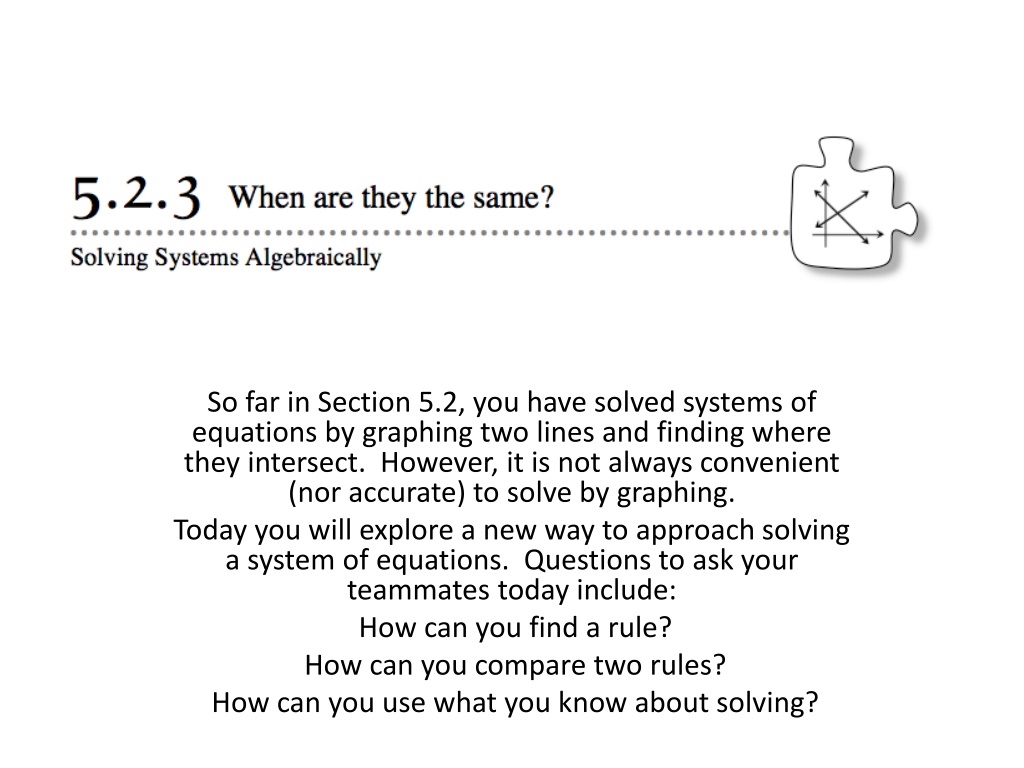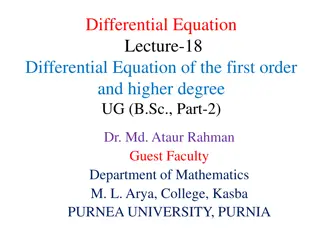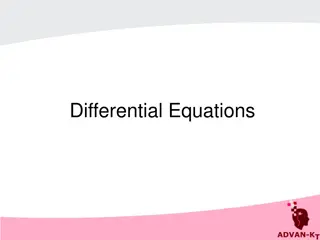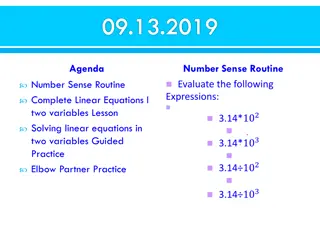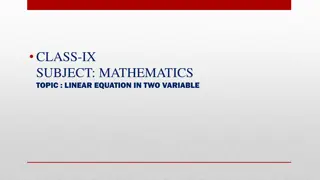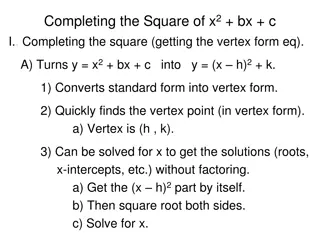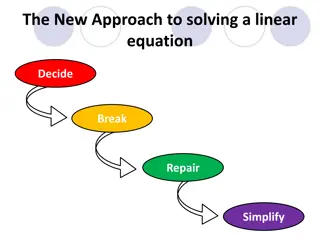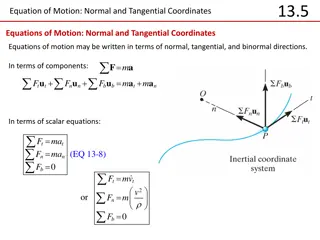New Approaches to Solving Systems of Equations
Explore solving systems of equations algebraically using rules, equations, and mathematical concepts rather than graphing. Understand how to find a rule, compare rules, and use algebraic methods to find solutions. Practice with scenarios like determining when two animals will weigh the same or predicting population changes in schools. Verify solutions through both graphical and algebraic methods.
Uploaded on Sep 13, 2024 | 0 Views
Download Presentation

Please find below an Image/Link to download the presentation.
The content on the website is provided AS IS for your information and personal use only. It may not be sold, licensed, or shared on other websites without obtaining consent from the author. Download presentation by click this link. If you encounter any issues during the download, it is possible that the publisher has removed the file from their server.
E N D
Presentation Transcript
So far in Section 5.2, you have solved systems of equations by graphing two lines and finding where they intersect. However, it is not always convenient (nor accurate) to solve by graphing. Today you will explore a new way to approach solving a system of equations. Questions to ask your teammates today include: How can you find a rule? How can you compare two rules? How can you use what you know about solving?
5-41. CHUBBY BUNNY Use tables and a graph to find and check the solution for the problem below. Barbara has a bunny that weighs 5 pounds and gains 3 pounds per year. Her cat weighs 19 pounds and gains 1 pound per year. When will the bunny and the cat weigh the same amount?
5-42. SOLVING SYSTEMS OF EQUATIONS ALGEBRAICALLY In problem 5-41, you could write rules like those shown below to represent the weights of Barbara s cat and bunny. For these rules, x represents the number of years and y represents the weight of the animal. Since you want to know when the weights of the cat and bunny are the same, you can use an Equation Mat to represent this relationship, as shown at right
5-42. SOLVING SYSTEMS OF EQUATIONS ALGEBRAICALLY a) Problem 5-41 asked you to determine when the weight of the cat and the bunny are the same. Therefore, you want to determine when the expressions on the left (for the bunny) and the right (for the cat) are equal. Write an equation that represents this balance. b) Solve your equation for x, which represents years. According to your solution, how many years will it take for the bunny and the cat to weigh the same number of pounds? Does this answer match your answer from the graph of problem 5-41? c) How much do the cat and bunny weigh at this time?
5-43. CHANGING POPULATIONS Post Falls High School in Idaho has 1160 students and is growing by 22 students per year. Richmond High School in Indiana has 1900 students and is shrinking by 15 students per year. a) Without graphing, write a rule that represents the population at Richmond High School and another rule that represents the population at Post Falls High School. Let x represent years and y represent population. b) Graphing the rules for part (a) is challenging because of the large numbers involved. Using a table could take a long time. Therefore, this problem is a good one to solve algebraically, the way you solved problem 5-42. c) Solve your equation to find out when the schools populations will be the same. What will the population be at that time?
5-44. PUTTING IT ALL TOGETHER Find the solution to the problem below by graphing and also by solving an equation. The solutions using both methods should match, so be sure to review your work carefully if the results disagree. Imagine that your school planted two trees when it was first opened. One tree, a ficus, was 6 feet tall when it was planted and has grown 1.5 feet per year. The other tree, an oak, was grown from an acorn on the ground and has grown 2 feet per year. When will the trees be the same height? How tall will the trees be when they are the same height?
5-45 Ms. Harlow calls the method you have been using today to solve equations the Equal Values Method. Explain why this name makes sense.
